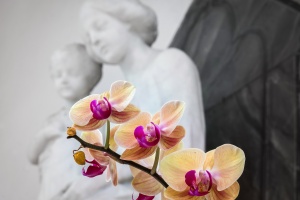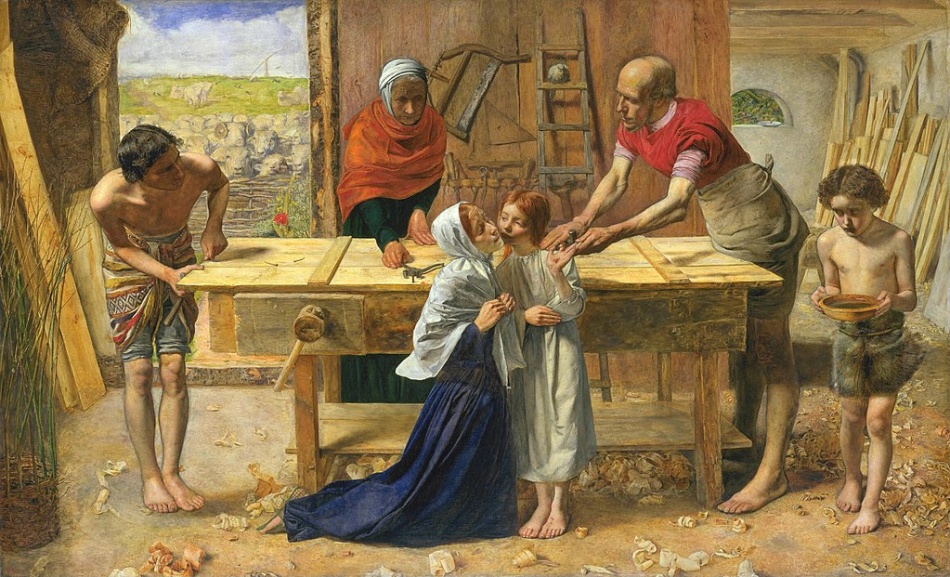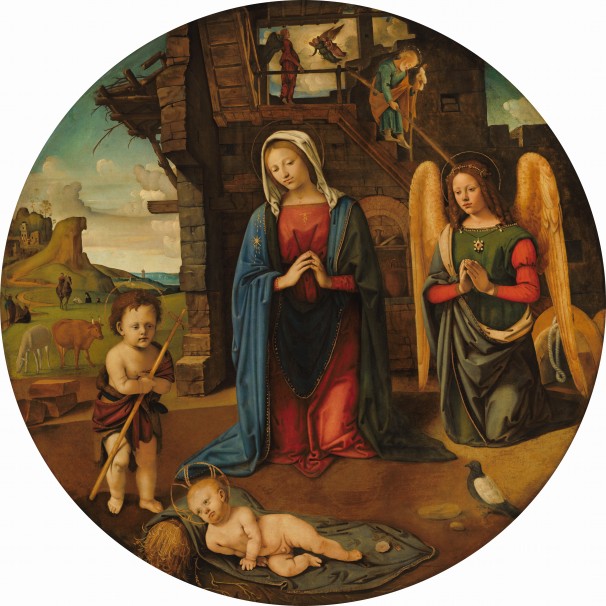Inspired Through Art: The Angelus by Jean-Francois Millet, 1857
One of the most famous Catholic paintings of history is the humble work of art titled The Angelus by Jean-Francois Millet. This painting might be considered unique in that it has been viewed as inspired fine art by some and purely sentimental illustration by others. What is in this image that stirs the aesthetic imagination for some and is dismissed by others as a simplistic work of religious nostalgia? Importantly, how does it incarnate the subject of prayer?
From the Shepherds: Beauty Is Necessary for Catechesis
 In 2020, the Shepherds of the Church gave us a treasure in the new Directory for Catechesis. Dr.
In 2020, the Shepherds of the Church gave us a treasure in the new Directory for Catechesis. Dr.
Inspired Through Art: The Adoration of the Shepherds by Giorgione, 1505-1510
O Come, Let Us Adore Christ Our Lord!
“Adoration is the first attitude of man acknowledging that he is a creature before his Creator,” notes the Catechism (2628). In adoration we exalt the greatness of God and express gratitude to Jesus Christ for reconciling us to God in the mystery of his Paschal death and Resurrection.
Saint Luke’s Gospel tells us that the good news of God’s reconciling the world through his Son came first to simple shepherds in the midst of their ordinary work. As they kept watch over their flock at night the shepherds were the first to hear of the birth of Jesus, announced by a host of angelic choirs. At the astounding news, the shepherds’ humble work transformed into prayerful adoration as they left their fields to adore the newborn Jesus in the blessed company of Mary, his mother, and Joseph, his guardian and protector.
It is this Gospel moment that the talented Venetian painter, Giorgione, captures in this beautiful sixteenth-century scene of the adoration of the shepherds. While Florence was the birthplace of the Italian Renaissance, the arts flourished equally in the city of Venice. Of particular interest to Venetian artists was the beauty of the natural world. So they painted Gospel scenes set in vibrant landscapes of green meadows, rocky hills, and winding streams. In his remarkable vision, Giorgione sets the Gospel scene of the adoration of the shepherds in a rich landscape of rolling fields contrasted against a rocky cave that comes alive with the good news of the incarnation of God in Jesus Christ.
Finding God in an Unexpected Place
 When John Everett Millais’ Christ in the House of His Parents was first displayed at the Royal Academy, the public response was near-universal revulsion.
When John Everett Millais’ Christ in the House of His Parents was first displayed at the Royal Academy, the public response was near-universal revulsion.
Inspired Through Art: Pentecost by El Greco
Pentecost, by the artist El Greco (c. 1597), is one of the most extreme images of an event in Scripture. What was the convergence of history, culture, and personality that led to El Greco’s image of the descent of the Holy Spirit as described in the Acts of the Apostles?
Children's Catechesis: Ennobling Our Families
Because of the pandemic, instead of working directly with children, many parish catechists are helping parents gain confidence in preparing their children for sacraments without traditional classes. I believe this new process can ennoble families to better assume their role in society.
“Ennoble,” according to the Merriam-Webster dictionary, means to “make noble or elevate.” (“Ennoble,” Merriam-Webster.com Dictionary, Merriam-Webster, https://www.merriam-webster.com/dictionary/ennoble.) Kings and queens elevate or “ennoble” a “commoner” to the status of “noble.” One cannot ennoble himself. He receives his nobility either through family inheritance, marriage, or as a gift bestowed by the proper authority.
As Catholics, our ennoblement begins at Baptism when we become members of God’s kingdom family with Christ as King. The liturgical rite itself is an ennobling gift received from the Church. The sacramental signs of candle and flame, water, oil, and white garment are gifts. So are the words of Sacred Scripture, the sign of the cross, and the renewal of baptismal promises.
At the baptism of our youngest grandchild, obligatory facemasks could not diminish the solemn dignity embodied by each member of baby Oliver’s family as we witnessed his two oldest siblings step up as godparents. Three generations were united by word and creed as we left the earthly realm of time and space to enter into the sacred liturgy and Oliver became a child of the King.
We could discuss in detail the ennobling qualities we receive in each of the Church’s sacraments, but let’s turn our attention instead toward ennobling practices Catholics can receive from the Church and adapt to family life.
Inspired Through Art: Annunciation of Victory over Death
In this article, we reflect on the painting, Christ Appearing to His Mother, by Juan de Flandes, Netherlandish ca. 1496.
There is a tradition from the thirteenth century of Jesus appearing to his mother after the Resurrection.[1] It is not mentioned in the New Testament, but as devotion to the Blessed Virgin Mother increased, her absence in the Gospel accounts of Jesus’ post-resurrection appearances raised the question. Is it likely that Jesus would have visited his mother, with whom he lived, as far as we can know, for all but the last three years of his life? And is it possible that the Gospel writers might not have chosen to mention such a filial, poignant and intimate meeting even if they knew about it?
In this painting, the artist imagines Jesus going to meet his mother immediately after he has risen from the dead. In the Gospel accounts we are told of Mary standing at the foot of the Cross, that Jesus gave John to his mother and John, “from that hour . . . took her to his own home” (Jn 19:27). Without doubt, Mary would have gone to John’s home and “kept all these things, pondering them in her heart” (Lk 2:19).
In and with Mary, our Holy Mother the Church has done the same, and her pondering has produced traditions and images that are not in the Scriptures, but which can help us appreciate more fully the depths of the immense mystery of our salvation.
Inspired Through Art: The Nativity with the Infant St. John by Piero di Cosimo

To project the artwork onto a smartboard click here.
Piero di Cosimo is one of the most interesting artists of the Renaissance. His biographer was Giorgio Vasari, the contemporary of Michelangelo who is considered to be the first art historian. Vasari collected stories about the most famous and popular artists from the Renaissance, and his book, The Lives of the Artists, became a bestseller. His narratives are full of personal remarks, perhaps based on hearsay and his own judgment, on the character of both the art and artists themselves. With that as the basis, we come to know Piero di Cosimo as a true eccentric. He had unusual habits and phobias that often kept him in seclusion. According to Vasari, he was deathly afraid of thunderstorms and fire, lived on a diet of hard-boiled eggs, and never cleaned his studio. He also had a deep love of nature, which usually showed in his painting of trees, rocks, animals, and the natural world. Despite his apparent eccentricities (if Vasari’s narrative is true), Piero accomplished a remarkable body of work, including this beautiful scene of the Nativity.
The Nativity with the Infant St. John is a tondo painting—one that is circular in shape, which was popularized in the Renaissance. While the subjects varied, the tondo sometimes functioned as a gift to celebrate a successful birth, called a desco da parto or “birth tray.” During the postpartum period a mother would receive limited guests, usually only females and family, and gifts and refreshment would be served from such an image framed and functioning as a tray. But the practical function was ritualistic only at first; later, the object would be hung as a framed work of art. A repeating iconographic subject for such a desco da parto was the birth of a saint, or as in the case here, the Nativity of Our Lord.
It is important to consider that the circular image would offer the artist the opportunity (or challenge) to compose “in the round.” If we consider the rose window in the Gothic Period as an immensely successful expression of circular composing, the relative flatness of a window permits the designer to think largely in two dimensions. But when an artist must conceive of the wholeness of three dimensions, the challenge increases. In a rose window, the form is of a flower or a wheel—petals or spokes radiating outward from a center ovule or hub. But in a painting of a landscape with human figures, how can an artist make a convincing picture and still get the sense that the circle’s form is important to the image and the image is important to the circle?
Circles are “perfect”; circles have no beginning or end—they are continuous with no parts or characteristics that offer differences, such as the corners found in squares or triangles, two other basic geometric forms. In that sense, circles are inscrutable. This is a good reason to symbolically associate circles with perfection and unity. One might also extend that comparison to God, who is a unity of pure being even in the perfect familial unity of the Trinity—a beautiful and mysterious paradox. In visual art, the circle is difficult as a basis for composition because there are no inherent parts to work with in a perfect circle—no horizontal and vertical edges, no corners or gravity. Any definition like up and down or side to side resists interpretation because the eye remains focused on the singularity of circularity as the dominant expression.
So Piero di Cosimo was given this commission and decided on the subject of the Nativity. When we study the painting, we can ask: what is this image about? What does the composition reveal? What did Piero want us to think as we contemplate its iconography?
The Family of Mary at Her Presentation in the Temple
Who prepared the young heart and mind of Mary to respond to God in humble faith with a fiat, her yes to the Archangel Gabriel? Where did Mary, the Mother of God, learn to listen attentively to God’s word?
The beautiful painting The Presentation of the Virgin in the Temple, by Italian artist Andrea di Bartolo in the first decade of the fifteenth century, offers insight into Mary’s life through one pivotal moment in her youth. This event, of course, is known largely from early apocryphal writings. In this masterpiece, the Sienese artist brings to life, in vivid detail, the hidden moment that prepared Mary to take her unique place in God’s plan of salvation. Striking in its simplicity and beauty, this image draws us into the mystery of Mary’s life, a life that always leads to her divine Son, Jesus.
Full of Grace
“Hail Mary, full of grace!” These words of the Archangel Gabriel spoken at the Annunciation are familiar words of Christian prayer. They teach us an important truth about the Mother of God. Long before the Annunciation, Mary was filled with grace. From the moment of her Immaculate Conception, Mary was preserved from the stain of original sin. She was “full of grace” from her conception in the womb of St. Anne to her glorious assumption into heaven.
Andrea di Bartolo was commissioned to paint a large altarpiece dedicated to scenes from the life of the Blessed Virgin Mary. This panel was one of three small panels that depicted the domestic church in which Mary was raised. Two other panels show the birth of Mary and the generosity of her parents, St. Joachim and St. Anne, in their almsgiving and care of the poor. In this scene, the artist shows Mary at her presentation in the temple when she was consecrated to God within the devotion and faith of her family.
The Family of Mary
“The family is the basic cell of society. It is the cradle of life and love, the place in which the individual ‘is born’ and ‘grows.’”[1] These words of St. John Paul II remind us that the family has a fundamental and formative role, both in society and in the life of each person. This is true of every Christian, and it is exemplified in a special way in the life of Mary.
Inspired Through Art: Death and the Miser by Hieronymus Bosch, c. 1490
The artist Hieronymus Bosch is a mystery of Art History. His role in the Northern Renaissance has made him a curiosity who has been admired, copied, and perhaps disdained as a madman. His paintings are fantastical always and religious usually, but religious in a unique, sometimes troubling and psychologically dark manner. He left no written documents or letters that might explain his ideas about painting, but he is mentioned in the archives of the Illustrious Brotherhood of Our Blessed Lady, a Netherlandish religious confraternity. His father was an artist, as were three of his brothers. He rarely dated his paintings and there has been endless speculation about his work, his life, and the meanings of his paintings. However, his work is full of intense expressions of the urgency of the human condition, of which Death and the Miser is an exceptional example.
While most of Bosch’s famous works include many figures crowded into strange environments, this scene of the miser’s bedroom is focused on one person, the man who has lived a life of greed. He has come to the last moments of his life; the final battle for his soul is happening. We are given an opportunity to watch his life unfold in a simultaneous narrative.
In the foreground, we see him in the fullness of life depositing money into a lockable chest, the keys for which are hanging from his waist. Also hanging from his waist and passing through his hand is a rosary. This indicates a moral conflict: praying and hoarding wealth do not go hand in hand except in the disordered mind of the miser. The room includes other attributes of worldly prestige and gain such as armor and documents sealed in wax (likely contracts or loan documents). Remember that usury was, and is, the sin of lending money at exorbitant rates of interest, a likely source of income for this miser. In the chest a demon holds open the bag for the coins. Indeed, demons are everywhere in the room, lurking around and poking their heads from behind a curtain, from under the chest and from over the canopy. Above the canopy is a vaulted passageway and the bed seems to be receding into a void of darkness. Death itself, with the face of a skull, enters through the door with an arrow. In the bed the miser, emaciated with a sickly color, is at the end. It is time to for him to decide: repentance or damnation. Salvation hangs in the balance! Which will it be?


